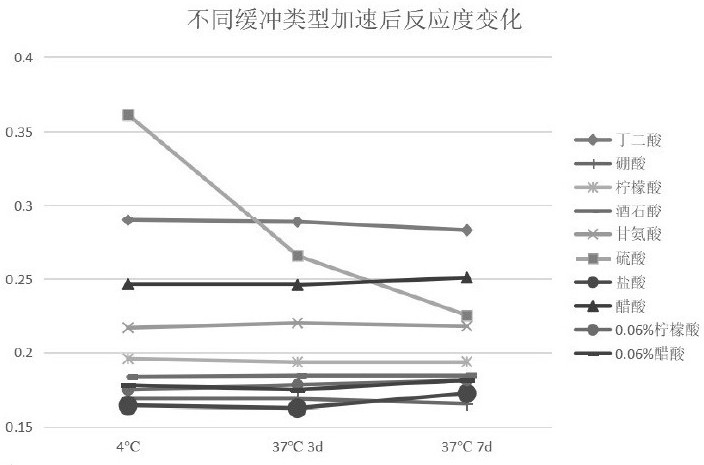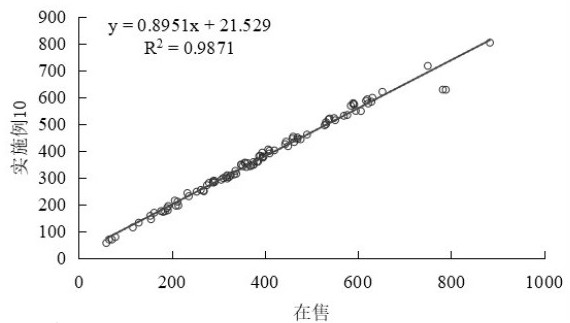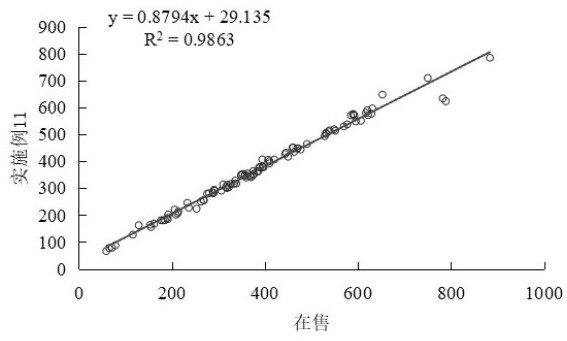Lipoprotein cholesterol detection method and kit
A technology of kits and reagents, applied in biochemical equipment and methods, measuring devices, microbiological determination/inspection, etc., can solve the problems of large low-end deviation of determination reagents, inability to achieve accurate detection, large deviation of external quality assessment, etc. , achieving high accuracy, meeting reagent linearity requirements, and good stability
- Summary
- Abstract
- Description
- Claims
- Application Information
AI Technical Summary
Problems solved by technology
Method used
Image
Examples
Embodiment 1
[0055] Example 1 Preparation of the kit
[0056] Taking the small and dense low-density lipoprotein cholesterol detection kit in the prior art as an example, the kit is divided into two reagent compositions, R1 and R2, and the specific formula is as follows:
[0057]
Embodiment 2
[0058] Example 2 Measurement method
[0059] Mix the serum sample to be tested with reagent R1, keep the temperature at 37 °C for 5 min, and measure the absorbance A. 1 , then add reagent R2, mix well, keep constant temperature at 37°C for 5min, and measure the absorbance A 2 , calculate ΔA=A 2 -A 1
[0060] (2) Use an automatic biochemical analyzer (Hitachi 7180) to measure the difference in absorbance after the reaction (main wavelength 546nm, secondary wavelength 660nm, instrument reading point 16-34);
[0061] (3) Calculate the concentration of sdLDL-C in the sample according to the change in absorbance.
[0062] Preferably, in the serum sample described in step (1), the volume ratio of reagent R1 to reagent R2 is 3:150:50.
[0063] (4) Linear experimental method:
[0064] Mix the high concentration sample close to the upper limit of the linear range and the low concentration sample close to the lower limit of the linear range into 7 dilution concentrations (see the ...
Embodiment 3
[0085] Example 3 Color source substance concentration screening
[0086] 1. Experimental method:
[0087] According to the kit components and contents in Table 1, reagents containing different chromogenic substances were prepared, wherein the chromogenic substances were TOOS, and the concentrations were: 0.4 mM, 0.8 mM, 1.6 mM, 2.0 mM, 3.2 mM, respectively. Linearity verification was performed with reagents with different TOOS concentrations, and the linearity practices and requirements were the same as above.
[0088] 2. Experimental results:
[0089]
[0090]
[0091]
[0092] It is found through experiments that the correlation coefficient r of the assay kit complies with the regulations, but from Table 2, it can be seen that the reagents in the kit in Table 1 have large low-end deviation and poor linearity, and the present invention adjusts the concentration of color source substances. , at the concentration of 0.4mM-3.2mM, it does not meet the range of 40-200mg...
PUM
| Property | Measurement | Unit |
|---|---|---|
| concentration | aaaaa | aaaaa |
| concentration | aaaaa | aaaaa |
| correlation coefficient | aaaaa | aaaaa |
Abstract
Description
Claims
Application Information
 Login to View More
Login to View More - R&D
- Intellectual Property
- Life Sciences
- Materials
- Tech Scout
- Unparalleled Data Quality
- Higher Quality Content
- 60% Fewer Hallucinations
Browse by: Latest US Patents, China's latest patents, Technical Efficacy Thesaurus, Application Domain, Technology Topic, Popular Technical Reports.
© 2025 PatSnap. All rights reserved.Legal|Privacy policy|Modern Slavery Act Transparency Statement|Sitemap|About US| Contact US: help@patsnap.com



